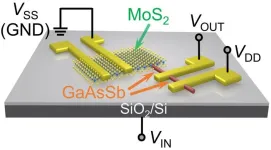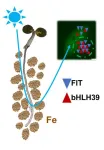(Press-News.org) Downscaling of electronic devices, such as transistors, has reached a plateau, posing challenges for semiconductor fabrication. However, a research team led by materials scientists from City University of Hong Kong (CityUHK) recently discovered a new strategy for developing highly versatile electronics with outstanding performance, using transistors made of mixed-dimensional nanowires and nanoflakes. This innovation paves the way for simplified chip circuit design, offering versatility and low power dissipation in future electronics.
In recent decades, as the continuous scaling of transistors and integrated circuits has started to reach physical and economic limits, fabricating semiconductor devices in a controllable and cost-effective manner has become challenging. Further scaling of transistor size increases current leakage and thus power dissipation. Complex wiring networks also have an adverse impact on power consumption.
Multivalued logic (MVL) has emerged as a promising technology for overcoming increasing power consumption. It transcends the limitations of conventional binary logic systems by greatly reducing the number of transistor components and their interconnections, enabling higher information density and lower power dissipation. Significant efforts have been devoted to constructing various multivalued logic devices, including anti-ambipolar transistors (AAT).
Anti-ambipolar devices are a class of transistors in which positive (holes) and negative (electron) charge carriers can both transport concurrently within the semi-conducting channel. However, existing AAT-based devices utilize predominately 2D or organic materials, which are unstable for large-scale semiconductor device integration. Also, their frequency characteristics and energy efficiency have rarely been explored.
To address these limitations, a research team led by Professor Johnny Ho, Associate Vice-President (Enterprise) and Associate Head in the Department of Materials Science and Engineering at CityUHK, embarked on research to develop anti-ambipolar device-based circuits with higher information density and fewer interconnections, and explore their frequency characteristics.
The team created an advanced chemical vapour-deposition technique to create a novel, mixed-dimensional hetero-transistor, which combines the unique properties of high-quality GaAsSb nanowires and MoS2 nanoflakes.
The new anti-ambipolar transistors had exceptional performance. Owing to the strong interfacial coupling and band-structure alignment properties of the mixed-dimensional GaAsSb/MoS2 junction, the hetero-transistor has prominent anti-ambipolar transfer characteristics with the flipping of transconductance.
The flipping of transconductance doubles the frequency in response to the input analog circuit signal, greatly reducing the number of devices required compared to conventional frequency multiplier in CMOS technology.
“Our mixed-dimensional, anti-ambipolar transistors can implement multi-valued logic circuits and frequency multipliers simultaneously, making this the first of its kind in the field of anti-ambipolar transistor applications,” said Professor Ho.
The multi-valued logic characteristics simplify the complicated wiring networks and reduce chip power dissipation. The shrinking of device dimensionality, together with the downscaled junction region, render the device fast and energy efficient, resulting in high-performance digital and analog circuits.
“Our findings show that mixed-dimensional anti-ambipolar devices enable chip circuit design with high information storage density and information processing capacity,” said Professor Ho. “So far, most researchers in the semiconductor industry have focused on device miniaturization to keep Moore's law rolling. But the advent of the anti-ambipolar device shows the comparative superiority of the existing binary logic-based technology. The technology developed in this research represents a big step towards next-generation multifunctional integrated circuits and telecommunications technologies.”
The research also opens the possibility of further simplifying complex integrated circuit designs to improve performance.
The mixed-dimensional anti-ambipolar device’s transconductance-flipping feature has shown the possibility of versatile applications in digital and analog signal processing, including ternary logic inverters, advanced optoelectronics and frequency-doubling circuits. “The new device structure heralds the potential of a technological revolution in future versatile electronics,” added Professor Ho.
The findings, titled “Multifunctional anti-ambipolar electronics enabled by mixed-dimensional 1D GaAsSb/2D MoS2 heterotransistors”, were published in the scientific journal Device.
Dr Wang Wei, a PhD graduate in the MSE at CityUHK, is the first author, and Professor Ho is the corresponding author. Collaborators include Dr Yip Sen-po, a CityUHK PhD graduate, supervised by Professor Ho, who is currently working in Kyushu University in Japan.
The research was funded by the Research Grants Council of the Hong Kong Special Administrative Region and the Shenzhen Municipality Science and Technology Innovation Commission.
https://www.cityu.edu.hk/research/stories/2024/02/23/mixed-dimensional-transistors-enable-high-performance-multifunctional-electronic-devices
END
Mixed-dimensional transistors enable high-performance multifunctional electronic devices
2024-02-23
ELSE PRESS RELEASES FROM THIS DATE:
Biomolecular condensates – regulatory hubs for plant iron supply
2024-02-23
Iron is a micronutrient for plants. Biologists from the Institute of Botany at Heinrich Heine University Düsseldorf (HHU) describe in a study, which has now been published in the Journal of Cell Biology, that regulatory proteins for iron uptake behave particularly dynamically in the cell nucleus when the cells are exposed to blue light – an important signal for plant growth. They found that the initially homogeneously distributed proteins relocated together into “biomolecular condensates” in the cell nucleus shortly after this exposure.
Both iron deficiencies and excesses are problematic for plants. They ...
PolyU researchers introduce biomineralization as a sustainable strategy against microbial corrosion in marine concrete
2024-02-23
Microbially induced corrosion (MIC) is a prevalent issue in marine environments, leading to structural damages such as cracking in concrete infrastructure. This corrosion poses a persistent challenge, significantly reducing the lifespan of marine structures and resulting in substantial economic losses. In response to the need for an effective solution to combat the marine corrosion on concrete, researchers of the Hong Kong Polytechnic University have developed a biomineralization approach to protect marine concrete from MIC.
Prof. ...
Genes affect your blood pressure from early childhood
2024-02-23
Certain genes associated with hypertension affect blood pressure from early in life, and they increase the risk of cardiovascular disease as you get older. However, you can do something about it.
“We are talking about really small differences, so small that they may fall within what is considered normal blood pressure. The problem is that they tend to last your whole life,” says PhD Candidate Karsten Øvretveit at the Norwegian University of Science and Technology's (NTNU) Department of ...
Streams connected to groundwater show improved detoxification and microbial diversity
2024-02-23
Washington, D.C. — Feb. 23, 2024 —Streams with ample connections to shallow groundwater flowpaths have greater microbial diversity and are more effective at preventing toxic forms of metals—often products of upstream mining—from entering and being transported downstream. These streams are also better at detoxifying those metals already present. The research is published this week in Applied and Environmental Microbiology, a journal of the American Society for Microbiology.
Under favorable conditions, the zone lining a stream channel stores nutrients and oxygen that meet nutritional and respiratory needs of local invertebrates and fish. That ...
Almodóvar receives NIH grant to study pulmonary hypertension in HIV patients
2024-02-23
Across the globe, more than 39 million people are living with the Human Immunodeficiency Virus (HIV), the virus that causes AIDS, including more than 1.3 million new HIV diagnoses last year. The majority of those afflicted — approximately 76% — have access to antiviral therapy that allows them to live with HIV as a chronic disease.
Sharilyn Almodóvar, Ph.D., from the Department of Immunology and Molecular Microbiology at the Texas Tech University Health Sciences Center (TTUHSC) School of Medicine and the TTUHSC Graduate School of Biomedical Sciences, said that even with the widespread ...
SK bioscience’s typhoid conjugate vaccine achieves WHO prequalification
2024-02-23
WHO PQ paves the way for public procurement of SKYTyphoid™ by UN organizations
Addition of new vaccine will diversify, expand TCV supply amid expected growing demand
February 23, 2024, SEOUL, Korea – SK bioscience and the International Vaccine Institute (IVI) announced today that the typhoid conjugate vaccine developed by SK bioscience with technology transfer from IVI has achieved the World Health Organization prequalification (PQ), which paves the way for public procurement of the vaccine by UN organizations and gives a boost to the global TCV supply.
WHO PQ certifies the safety, efficacy, and GMP of a vaccine by evaluating its manufacturing ...
The American College of Medical Genetics and Genomics (ACMG) releases points to consider statement on the safety and efficacy of polygenic risk score assessment for embryo selection
2024-02-23
Should we be using polygenic risk score assessment for embryo selection? Providing in-depth analysis, the Social, Ethical and Legal Issues Committee of the American College of Medical Genetics and Genomics (ACMG) has released a new Points to Consider statement to assist healthcare professionals and patients in understanding the safety and utility of preimplantation genetic testing for polygenic disorders (PGT-P) as a clinical service.
“Clinical Utility of Polygenic Risk Scores for Embryo Selection: A Points to Consider Statement of the American College of Medical Genetics and Genomics (ACMG)” was published in the College’s flagship journal, Genetics ...
PolyU researchers introduce biomineralisation as a sustainable strategy against microbial corrosion in marine concrete
2024-02-23
Microbially induced corrosion (MIC) is a prevalent issue in marine environments, leading to structural damages such as cracking in concrete infrastructure. This corrosion poses a persistent challenge, significantly reducing the lifespan of marine structures and resulting in substantial economic losses. In response to the need for an effective solution to combat the marine corrosion on concrete, researchers of the Hong Kong Polytechnic University have developed a biomineralization approach to protect marine concrete from MIC.
Prof. ...
UBC Okanagan researchers look to the past to improve construction sustainability
2024-02-23
Researchers at UBC Okanagan are revisiting old building practices—the use of by-products and cast-offs—as a way to improve building materials and sustainability of the trade.
A technique known as rammed earth construction uses materials that are alternatives to cement and are often more readily available in the environment. One such alternative is wood fly ash, a by-product of pulp mills and coal-fired power plants, explains Dr. Sumi Siddiqua, with UBC Okanagan’s School of Engineering.
Industry has been trying to find a use for materials like fly ash ...
New study identifies potential gene targets for management of cassava whitefly, key vector of viral diseases threatening African food security
2024-02-23
Whiteflies, particularly the African cassava whitefly (Bemisia tabaci, SSA1-SG1), pose a significant threat to agricultural productivity in Sub-Saharan Africa by transmitting viruses that cause cassava brown streak disease and cassava mosaic virus disease. In a new study published in PeerJ Life & Environment, Dr. Tadeo Kaweesi and his team at the National Agricultural Research Organization identify potential gene targets that could revolutionize the management of this devastating pest and prove vital for food security in the region.
In the article ("In silico prediction of candidate gene targets ...







